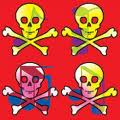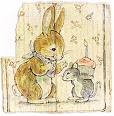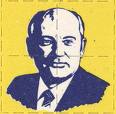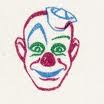Acid House
SF Weekly, Aug. 30, 1995 MiscellanyThe art of LSD blotter paper.
 "These are symbols of a secret society," says Mark McCloud, gesturing to the scores of LSD blotter paper hanging in the living room of his Victorian home in the Mission.
"These are symbols of a secret society," says Mark McCloud, gesturing to the scores of LSD blotter paper hanging in the living room of his Victorian home in the Mission.
"And I am the mule that has dragged the cultural evidence to town."
The variety and beauty of McCloud's blotters are stunning. There, mounted under glass in an elegant frame, is one depicting Ganesha, the elephant-headed god of Hinduism. Over there, pink flying saucers. The peace dove. More blotters just this side of the pile of guitar cases and the Hohner bass. And still more between the "CY KDLC" California license plate and the Macintosh whose screen saver continually etches a psychedelic chiaroscuro: Mr. and Mrs. Dancing Test Tube; the zodiac; the eye in the pyramid; and poster and cartoon images appropriated from Stanley Mouse, Spain Rodriguez, and R. Crumb, as well as Walt Disney.
"There's an aesthetic governing each effort," the 41-year-old McCloud says, but he laughs and shakes his head as he hoists framed blotters emblazoned with the Ozzy Osbourne logo.
"What kind of state of mind do you have to be in to take a hit of Ozzy Osbourne?!"
The more relevant question is, "What sort of state of mind do you have to be in to welcome a reporter into your living room and share with him your clandestine trove from the underground?" Actually, says McCloud, there is little if any legal risk in possessing these papers. Exposure to sunlight and heat has destroyed the illegal drug in every one of the blotters that he displays, reducing the LSD to an inert and legal compound.
"Try to eat these," he says of his mounted samples, "and you choke on the frames."
McCloud's collection of 250 different blotters, meticulously assembled over the last 20 years, comprises a psychedelic Smithsonian exhibit--a document of the Age of Acid that reveals the artistic strivings of the marketers of the quintessential drug.
It's a collection freighted with controversy, as one critic noted in 1987. "The intense emotions surrounding LSD make it forever difficult to objectively judge the artistic merit of these prints, and the way in which we see this drug in the future could well determine whether this collection ends up in a church, a museum, or a garbage can," wrote Carlo McCormick.
The earliest clandestine LSD was dolloped on sugar cubes or impregnated in tablets or capsules, say authorities at the Drug Enforcement Administration's (DEA) Special Testing and Research Laboratory, which maintains an archive of hundreds of unique LSD samples for forensic purposes. It wasn't until the very late '60s and early '70s that other, more imaginative mediums were devised to ferry the drug. According to anecdotal sources and the less-than-authoritative High Times Encyclopedia of Recreational Drugs, Crumb's cartoon character Mr. Natural was among the initial blotter paper designs. (Some acidheads say they ate their first dose of Mr. Natural in the very early '70s.) Mr. Natural quickly begat new blotters, as artists pinched images from the religious pantheon, from pop culture, and from fine art. Some even devised original artworks to market their acid.
 Although 95 percent of all acid the DEA and McCloud encounter today is in blotter form, other varieties are vended. "Microdot" pills, which are slightly larger than a poppy seed and were popular in the late '60s, are still sold. So is "windowpane," clear or colored pharmaceutical gel imbrued with LSD, a concoction that appeared in the early '70s.
Although 95 percent of all acid the DEA and McCloud encounter today is in blotter form, other varieties are vended. "Microdot" pills, which are slightly larger than a poppy seed and were popular in the late '60s, are still sold. So is "windowpane," clear or colored pharmaceutical gel imbrued with LSD, a concoction that appeared in the early '70s.
(McCloud also collects the gels, some of which are pyramidal in shape and "better appreciated as sculpture," he says.)
McCloud, who emigrated from Argentina when he was 8, traces his curatorial enthusiasm to high school at the Webb School for Gentlemen, a Claremont, Calif., boarding school. One day, a narcotics officer visited Webb to give an anti-drug talk, and supplemented his sermon with the visual aid of a comprehensive drug collection.
"There were all these little bundles and syringes and pipes arranged in this vitrine," he says. "I said, 'Wow, pretty weird.' "
At the time, McCloud was an enthusiastic coin collector, and the narc's stash-in-a-glass-box planted the seed for the collection the aspiring artist would start in 1975, just a few years later, as the festively printed blotters proliferated on the street.
"I had collected blotters before, but [1975] was the first conscious effort to preserve it. The collection lived in the refrigerator for the first eight years--for a long time I didn't know which way it was going to go," McCloud says. "I can't tell you how many collections I ended up munching."
Although the art of blotter has evolved over the decades to make statements political (the FBI seal) and religious (the mandala), the "industry" has settled on something close to a standard in size and potency. According to the DEA, most full sheets of acid measure 8 1/2 inches wide by about 11 inches tall and are perforated into 1,000 quarter-inch by quarter-inch squares (25 by 40). The average dose is 30 to 50 micrograms per blotter, although the DEA sees blotters that contain as much as 85 micrograms of LSD, as few as 14 micrograms, or no drug at all.
Deliberately vague about the origins of his specimens, McCloud says acquaintances sometimes give him samples of acid that they've owned for years and never gotten around to taking. He also says that he's made connections with the artists who design the blotters and the chemists who synthesize the drug. If that's true, McCloud has done a better job of penetrating the acid underground than the government, whose efforts over the years to topple the LSD trade have been futile. Despite spending hundreds of millions of dollars on surveillance and enforcement, establishing a nationwide network of informants, monitoring the drug's precursor chemicals (ergotamine tartrate and lysergic monohydrate), and conducting a decades-long drug-education campaign that some say exaggerates the dangers of moderate LSD use, the government has utterly failed to curb makers and users. A full two decades have elapsed since the DEA or any other law enforcement agency has made a significant bust of an LSD lab; most arrests have been of middlemen and retailers.
Push Mark McCloud--or the DEA, for that matter--too hard for specifics about the acid market, and you'll encounter stubborn resistance. The world of LSD is truly secret.
"There are four 'families' that control production," claims McCloud.
 The DEA believes that most of the world's LSD supply emanates from the United States, and pegs the approximate number of domestic producers to fewer than 10. Deducing an exact number is difficult; the labs don't volunteer themselves for an annual census and, as noted before, they don't get busted. Also, the quantity of LSD contained on the quarter-inch by quarter-inch perfs is minute--just millionths of a gram--which stymies DEA chemists' efforts to match "signature" impurities from one sample to another.
The DEA believes that most of the world's LSD supply emanates from the United States, and pegs the approximate number of domestic producers to fewer than 10. Deducing an exact number is difficult; the labs don't volunteer themselves for an annual census and, as noted before, they don't get busted. Also, the quantity of LSD contained on the quarter-inch by quarter-inch perfs is minute--just millionths of a gram--which stymies DEA chemists' efforts to match "signature" impurities from one sample to another.
The DEA and McCloud concur that untold hundreds of blotter-makers produce the final product, with the acid curator volunteering that at one time the families provided distributors with both printed blotter and LSD. He says the families exited the risky business of printing to reduce the chances of getting caught and leading the cops back to the lab.
While the DEA keeps its LSD archive locked in file flats in a nondescript building in the Washington, D.C., suburbs, McCloud has been sharing his for eight years. The first public exhibit was at San Francisco's Art Institute in 1987, which attracted the attention of the San Francisco County Fair. The fair convinced McCloud to commemorate the 20th anniversary of the Summer of Love by entering his blotter aggregate in competition with other odd collections.
"It won a red ribbon," McCloud says, gesturing to his second-place prize on the living room wall. "A collection of burger [patty] presses won first. Going up against burger presses--I can't say I disagree with the judges' decision."
The show traveled east to New York and Houston in '87 and '88, and is now enjoying its first run at Philip Cushway's Artrock gallery, where acid avatar Timothy Leary was the guest of honor for the Aug. 10 opening.
"The crowd for the Leary appearance was amazing," says Cushway, whose gallery sells and exhibits rock and psychedelic memorabilia. "There were hippies, punks, and middle-aged people--the broadest range of people I've seen here."
"It's like another folk art," he says of blotter. "And it's collectible. It's paper. It's aesthetic. It's attractive. It's tactile. It's frameable."
"It was good to have Leary open the show," says McCloud. Gaunt and suffering from cancer, the 75-year-old was his playful self, going so far as to embrace his neo-senility as another gift of consciousness.
McCloud, meanwhile, is qualified to present the high art of LSD if only because he boasts a high-art background. He earned an M.F.A. in art at UC Davis in 1977, and taught art from 1981 to 1991 at St. Mary's College and the University of Santa Clara. But that career was interrupted in 1992, when he received what he calls "the black kiss" from the FBI. Agents arrested him on "conspiracy to distribute LSD" charges.
"They said I was the 'Cadillac Man,' " McCloud says, and alleged that he had made a major drug buy on Market Street.
Put on trial in Houston in May 1993, McCloud faced a minimum of 10 years in prison. Luckily for him, he hails from a wealthy family who could afford to hire San Francisco defense attorney Doron Weinberg to prepare a thorough defense. After the prosecution presented several days worth of evidence and testimony, the judge, without hearing a word from the defense, granted a judgment of acquittal.
"Doron Weinberg saved my life," McCloud says.
Not to mention the collection.
Blotter acid is unique among recreational drugs in that it allows users to choose their illusion. "What'll you have, sacred or profane?" the illustrations seem to squawk. If you crave the holy, here are yin/yang, the floating lotus, the Sphinx, and occult blotters. If you feel like a loopy time, have some Beavis and Butt-head, silver UFOs, Mickey Mouse in Fantasia sorcery drag, or blotters of Alice Through the Looking Glass.
The designs also illuminate the ongoing schism in the LSD community. It's a dispute that goes back to the mid-'60s, when the drug enjoyed its first mass popularity. On one side were the earnest psychic explorers at Millbrook, led by Leary, who viewed the drug as a key to consciousness, a magic potion that revealed religious truths. On the other stood Ken Kesey's gang of Merry Pranksters, who regarded LSD as a cosmic goof, a universal passport to adventure in the kingdom of comic-book heroes.
 The coin collector in McCloud looks upon the fancy blotters as a quasi-currency for the underground, a medium of exchange that is as anarchistic as it is karmically balanced. (There's a commemorative quality to blotter, too. One sample in McCloud's show depicts Albert Hofmann, "Father of LSD.") Indeed, great quantities of genuine currency change hands in the LSD trade, but the margins are enough to make the average cocaine dealer wince. According to the DEA, the wholesale price of LSD in San Francisco ranges between 40 cents and $1 per hit based on transactions of 1,000 hits, and the retail price ranges from $1 to $5. Back in 1978, LSD traded for $1 to $3 a hit, which means that adjusted for inflation the price of LSD has actually dropped in the last 17 years.
The coin collector in McCloud looks upon the fancy blotters as a quasi-currency for the underground, a medium of exchange that is as anarchistic as it is karmically balanced. (There's a commemorative quality to blotter, too. One sample in McCloud's show depicts Albert Hofmann, "Father of LSD.") Indeed, great quantities of genuine currency change hands in the LSD trade, but the margins are enough to make the average cocaine dealer wince. According to the DEA, the wholesale price of LSD in San Francisco ranges between 40 cents and $1 per hit based on transactions of 1,000 hits, and the retail price ranges from $1 to $5. Back in 1978, LSD traded for $1 to $3 a hit, which means that adjusted for inflation the price of LSD has actually dropped in the last 17 years.
In a world filled with signs and burgeoning with pharmaceutical newcomers, blotter endures, providing the promotional punch of Madison Avenue and the mystery of the cabala. Because the quality and quantity of the acid is unknown prior to consumption, the artwork serves as a promise (sometimes broken) of the trip to come while simultaneously conveying the designers' sense of fun and wonder, their devotion to an underground and outlaw culture, and the universality of religious hunger.
As Carlo McCormick writes in the notes accompanying McCloud's first exhibit, "The knowledge that the paper is dosed cannot but affect how one looks at the picture. Even odder, however, is that the picture has a way of influencing one's notion of the acid. So mighty is the power of suggestion here that it seems to signify some secret knowledge or expectation of the trip, as if the ink could predict, direct, or code one's experience."
In the cosmic clown vs. the inner truth debate, McCloud comes down decidedly on the inner-truth side.
"The pope has been passing blanks for years; this collection represents the return of the host to the people," he says. The anonymous makers adorn, garnish, and embellish their product for spiritual reasons, he adds.
"They're going the extra mile because of the substance itself. The material demands that sort of excellence," McCloud says.
Acknowledging that excellence while maybe not fully appreciating it is the DEA chemist back East who examines LSD samples from all over the world.
"In the last year we've seen the return of very psychedelic, arty, and colorful designs," a law enforcement official says. "One recent exhibit from San Francisco depicted the crucifixion of Christ in full color. You could put it in a gallery."
Exactly McCloud's point.
(Reprinted from SF Weekly with permission.)
